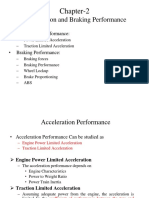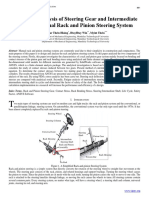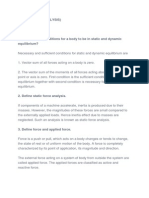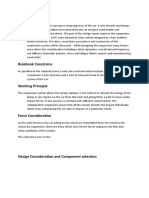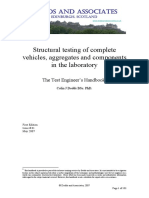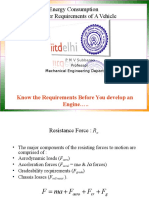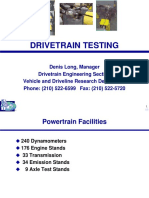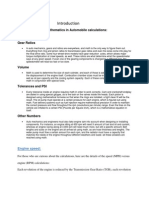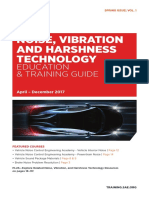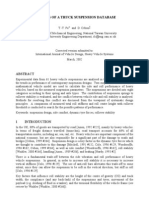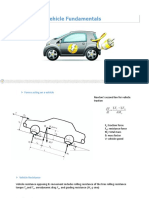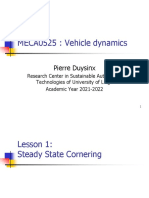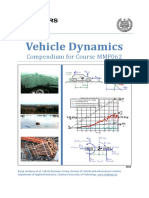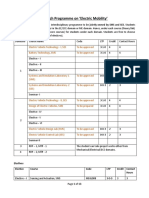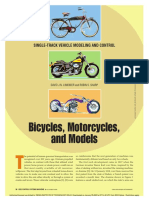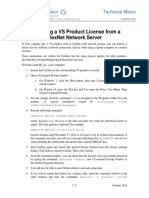0 ratings0% found this document useful (0 votes)
289 views258 pagesVehicle Dynamics Ellis
Uploaded by
Husain KanchwalaCopyright
© © All Rights Reserved
We take content rights seriously. If you suspect this is your content, claim it here.
Available Formats
Download as PDF or read online on Scribd
0 ratings0% found this document useful (0 votes)
289 views258 pagesVehicle Dynamics Ellis
Uploaded by
Husain KanchwalaCopyright
© © All Rights Reserved
We take content rights seriously. If you suspect this is your content, claim it here.
Available Formats
Download as PDF or read online on Scribd
You are on page 1/ 258
VEHICLE DYNAMICS
Fernands Ribese da Site
ser - 97
Lit 094K
VEHICLE DYNAMICS
Professor J. R, Ellis, M.Sc. (Eng.), Ph.D., F.l.Mech.E.
Advanced School of Automobile Engineering, Cranfcld
£42
Se;
LONDON
BUSINESS BOOKS LIMITED
Ft pubis 1949
(© 1969 JOHN RONAINE ELLIS
hs reserved, Except for normal review purposes no pat this book may be reproduced owed
many form orb any means clerons or mechan. incling photocopying, cording oy any
information storage and reer sysen, without permlaon othe pubes
SON 22099029
anese | 100213.
“his bok has een sn 1009 12 pl Tis Roman (Monopoo) prin
(Norwich Ld forthe publshers Business Rooke Listed ested oer: 10 eet Suet, London,
EC publbing oes: Mercury Howse, Wazoo Rad, London, SE
MADE AND PRINTED IN GREAT BRITAIN
|
.
CONTENTS
Prac xv
Chapter 1 the pneumatic tyre 1
1M State re tess []1.2 Rolling ye tents ground reactions] 3 Tyr oc and women's]
14 Comment (315 The ye on th sehie[]1.6 Tye-road ction 11.7 Tyreto-ye variations
[4 The dyeamie respons of rer] 19 Tye et dala] L10 An approximation to aliow for
teatve frees] 1.1 Some theories of literal tye fore 112 Tau string analogy 13 A
‘comment on paca ater sfc) 11 Beamon ate support theory) 11S The ember
Shel []L16 A theory of th anient response fee [) 17 Sinusoidal change inthe angle of
fidetip(} 1.18 Simplifedrspone equation ]119 Geometric simmny”[1.20 Dynamic whee!
“shimmy"[) 1.21 Equivalence of wheel and pound oess[]1.22 Concusons[] 123 Reeences
Chapter 2 applied mechanics 45
21 Axesoeferene moving wth he vebce122 Moments and produ one ]23 Vehice
angles()24 Sait of namic ptm) Crea ably ceria) 26 Reece
Chapter 3 the control and stability of a simple car 60
11 Fined ais modst[].12 Analysis wing body cotred ator}. Steady sate rerponter oeerng
input ()34 Satie margin and neural ster point) 38 Steady sate sponses to a extra lateral
fore andyeping moment(]26 Ackermann agle[137 Responses es of re chaaceitia)
18 Calelation of steady state esponser to nocring pat [39 Transient response characterises)
10 The car with setip resdom only] 241 The cr with aw freedom only(]412 ‘Single
dec of reedonveile(].43 Tw dere of feedom tame responses (3. The tral
Frequency (315 Motion in reponse to stcrng input] 316 fst of active rqutementC)
347 Overs and undersor[']34R Velie testing (349 Constant ea en []220 Constant
speedtest ()3.21 Aerodynamic efes(] 322 Conlusons 328 Reerense
Chapter 4 the articulated semi-trailer vehicle 93
‘1 The inane ebice}42 Steady tte cing eaponses 143 Callan of end sate
ving reponte(J44 Tease responses (J45 Concinions (46 Retrene
vt contents.
Chapter 5 suspension mechanics 106
54 “tll ais assumption C]32 RotlenteL}53 Wheel amber and rb 'C] 4 Eten sag
sileses(}39 Beam ane estes] $6 Alena meted fore eum)
57 Macpherson suspension [88 Veo diagrams for an arbitrary centre af lation (59 Roll
‘siance of dampers} 540 Roll angle)S11 Lond ant cron thetyes(]812 Rear all
‘totale spring sien 313 Suspension amie properia 1514 Sing le eqotons
‘tmaion[ 513 Beam ae: equations of motion] 516 The rung fond wheel ]817 The
seeing mctonsm []318 Nowtinarles() S19 Supension deratves(]830 Seay sae boy
nlacement rom derivate noaionC)S3t Concstons [522 References
Chapter 6 the control and stability of a car with freedom to roll 137
{61 Suspension characterises (62 Extra forees(J63 Equations of motion CJ64 Steady sacs
5 Enample (166 Stability (J67 Approxinate solution af the characte equation
{58 Selation of equation of motion -}69 Applications (610 Nonlinear characterises)
{61 Inclined rol ani 6.12 Elects of design changes(]613 Condatons]6H4 Reeences
Chapter 7 analog simulation 12
1 low diagrams (72 Machine operons (73 Accuracy 174 Seale actors Seng vp
the equation [}76 Forcing []17 Recording] 78 Esample(-]19 Two depres offectom C)
10 Saling}7.11 Diode devices} 712 Vain fncion diode gecator[J713 Paral
serail equations
Chapter 8 analog simulation of some car models 200
{1 Car simulation [2 Second example 82 Alenaive mechanization C84 Reali wind
and soving inputs 8S Improved tr simulation 86 Adina suspension eects
127 Condsions
Chapter 9 further car models 229
21 Sone shortcoming of pce models] 92 A ct with exible tyres ()9.3 Pie degrees of
stom mods ([}84 The ree contol et] 9S Sk depres of edom model []96 Conlsons
Chapter 10 summary 238
index 241
LIST OF FIGURES
FIG 1 Hypothetical vehicle contol loop including driver
FIG 2 Portion of the control loop covered by this book
FIG 11 Stati yr tests,
FIG 1.2 Tyre distortion during steering and distribution of pressures within the contact area
integrated across the width of contact
FIG 13 Carpet graph of lateral force versus sideslip angle and normal free
FFIG 14. Eifec of inflation pressure on lateral force at constant normal force
FIG 1.5. The eect of camber angle on lateral force
FIG 1.6 Reduction in lateral force at constant sideslip ange duc to tractive effort
FIG 1.7 Curves obtained from simple addition of lateral Forcen
FIG 18 The actual lateral force developed is ss than shown in Fig. 1.7 because loud transfer
is dependent on the lateral force
FIG 19 Theefet of tractive effort on lateral fore at constant angles of sidslip for vavious
loads
FIG 110 Lateral force versus sdestip angle, tractive effort and load transfer
FIG 1.11 (a) Effect of road speed on tyre drag: (b) Increase in drag due to active effort.
FIG 1.12 (a) Effect of road surface condition; (8) Locked wheal retardation and sideways
force coefficient for smooth tread tyes on various wet surfaces
FIG 113 Characteristic plots of (a) smal and () large Muctuations of cornering force and self
aligning torque
FIG 1.14. The changes in radial fore and stipes around the periphery ofa tyre
FIG 1.15. The build up of lateral force with distance rolled
FIG 116. (a) The lateral fore (mean value) and the phase angle developed; (b) Mean ali
{orque and phase angle between torque and sinusoidal stecring input
FIG 1.17 (a) Cyclic variation in lateral force with sinusoidal displacement ofthe axle: (b) Mean
value of lateral foree developed during sinusoidal displacement ofthe whes}
FIG 1.18. The friction elipse concept relating the lateral force available for vehicle contol to
he braking or tractive effort applied tothe wheel
FIG 1.19 (a) Lateral force versus sideslip ange fr fre rolling; (b Lateral force vests tractive
effor at constant sdestip ange: (e) Carpet graph of atral fore. tractive efor and sideslip angle
FIG 1.20 Some ofthe tye models proposed fr analysis
FIG 121. The lateral deflection of the tread band of a tyre when a point lateral load is applied
FIGL22 Alten
angle of sdesip
FIG 1.24 Experimental measurement of lateral pneumatic sifnes
FIG 125. A diagram ofthe development of acral fore fora rolling tyre as proposed by Fiala
FFIG 1.26 Lateral defection curves assumed when the approach of Reference 1.10 wed to
‘expressions for lateral force and moment
vu
vin Uist OF FIGURES
FIG1L27 A non-steady mode of a rolling tyre
FIG 1.28 Whee! shimmy due tothe geometry ofthe laterally Mexible tyre
FIG 129 A simplified single degree of freedom model of dynamic shimmy
FIG 130. (@) Summation of the component forces at an element within the contact patch;
(6) The correspondence ofthe ground forces and moments and the moments and forees ofthe
Ssubliy axes) Tye characteristics are frequently messurd by dynamometers
FIG21 The body centred ais system
FIG.22 (Indicates the parallel displacement ofa st of axes; (6) Rotation ofthe axis set
produces new displacements ofthe clement of mass
P{e23. The direction cosines of succesive rotations about matally perp
FIG24 Axis movements required to determine the moments and products of net
FIG 3A A model of the directional stailiy of car which may move laterally and rotate
FIG32_ Inthe body centred axis model the front and rear whoos at replaced by single wheels
at te cent ofthe vehicle
FIG33. Steady state curvature responses fr two postions of the centre of gravity
FIG Yawing velocity cesponses in steady state
FIG35. Single degre of freedom system with sidslip velocity only
FIG36 Curves of ‘spring constant for various conditions
FIGA7 Determination ofthe effective Intra force coefficients for a car
FIG 38 The lateral force coefcients obtained from Fig, 37 for two conditions of tition
FIG39 Determination ofthe critical speeds of the rear whest drive cae
FIG310 The effect of tractive effort on the static margin of ear
FIG3I1 The original definition of oversteer
FIG 312 Measurement of underscer by the constant radius of turn test
FIGAI3 The constant speedtest. an alternative method of measuring understeer
FIG 14 The axis system adopted for measuring arodynamie forecs and moments
FIG15 Typical non-dimensional fore and moment eurves fora carina side wind
FIGA1 A non-lincar model ofthe articulated vehicle
FIG42 The velocities atthe ith whee!
FIG43 Some results obtained from the non-linear model
Steady state yawing velocitics, demonstrating the effect of fith whee! position
“The roll entre of linkage suspension
Some typical suspensions and thee roll centres
FIG $3_(@) The small dplacements about centres O, and 0; involved in rol of the body;
(6) Velocity diagram fr the suspension linkage
FIG 54 Equilibrium of forces in a suspension
FIGS. ‘The Macpherson suspens
FIG 86 A 'demonstration that £0
motements ofthe wheels
FIG 51 (a) Disposition of sprung and unsprung
‘moments involved in all f the body about the roll axis
FIGS A simpli analysis of the load transfer duc to body roll
FIG 59. Ancquivalnt tailing link to represent the oll ster ofa leat spring
FIG 5.10 The goometry ofa swing axle
FIG 5.11 The velocity of the conte of gravity ofa sprung mass
FIG 512 The external reactions caused bya Inerl fore atthe contre of gravity ofthe sprung
FIG S13 The beam axle suspension, dynamic analysis
FIG 5.14 Relative velocities acros the ends ofthe damper
FIG 515. Suspension derivative notation
adcular axes
about an
tion ofthe body about an arbitrary point causes serub
ss; (hy The axis system. forees and
List oF FiGuRES 1x
FIG 5.16. (a) The instantaneous centres of rotation fora vertical velocity of the body orig
(©) The instantaneous centres of rotation fo rotation ofthe body origin
FIG 5.17 Suspension derivatives
FIG 61. The ais system of the three degre of freedom car
FIG 62. The forees and moments acting on the thre degre of freedom ear
FIG 63. Modification of the two degre of freedom responses by inclusion of rll steer
FIG 64. The stability and wind axe, three degree of freedom car
FIG 65 Comparison of practical and theoretical steady state awing velociis for various
‘combinations of tyres and tyre pressures
FIG 66. The time lag between movement ofthe steering whee! and stcrng the road wheels
FIG 61 Experimental response times fora small ear compared with analog models
FIG 68 Experimental and computed roll response times
FIG 69 Test records from a small car with portable instrumentation
FIG 610 A manual atempt at sinusoidal steering a shown in Fig 69
FIG 611 Non-linear simulation of tyre characteristics
FIG 612 Comparison of analog simulation and tt results onthe elects of lateral force
FIG 6.13 Definition of path and course ertor
FIG 614 The transient response characteritics and the corresponding course and path
errors fora step input of steering at 60 mileyh
FIGGIS Thecfec of tyre non-linearity due to load transfer in roll onthe steady state responses
FIG616 The elfet of tye non-linearity duet load transfer in roll onthe transient responses
aL 88 fs forward speed
FIG 617 The transient responses of Fig 6.16 expressed in terms of course and path eroF
FIG 618 The path errors produced by modification of roll stcet
FIG 619 The dstibution of the roll siffaesss between the axle changes the steady state
responses and increasing the proportion of roll silfness reduces the course and path errors
FIG 620. Increasing the distance between the roll axis andthe centre of gravity ofthe sprung
mass increases the errors
FIG 621 Reducing the inclination of the roll axis has a beneficial efect on the path and
FIG 622 A forward shift of the centre of gravity reduces the course and path erors
FIG 623 The position ofthe unladen centre of gravity and the dispotable loads of some
typical eas and commercial vehicles
FIG 71 The low diagram
FIG 72 and FIG 73 Summing units
FIG 74” The integrator unit
FIG 75. The coefficient unit
FIG 76 A diferetiator
FIG 77 Assessing the accuracy of an analog system
FIG 78 Typical values of computing componcas for summing and integrating
FIG 19 Detailed setting ofthe computing unis to simulate single degre of rcedom system
FIG 710. Some typical results which ate obtained from the simolaion shown in Fig 79
FIG 7.11 A simplified example ofa two mass system represeating the body and tyre
FIG 742 Some alternative forms of mechanization which wll produce a satisfactory solution
FIG 713 ‘Bang-bang circuit, simple friction simulation
FIG 714 "Bang-bang’ unit connected into the two degre of freedom system
FIG 715 Half wave rctlication with dead zone
FIG 7.16 Dead zone or clearance network
FIG 717 Adjustable limiting circuit
FIG 718. Simulation of regular disturbances
FIG 719 Absolute valve network
x Ust oF FiGuRES
FIG 7.20. A number of dead zone networks plus a base ental gain provide a characteristic
suitgble for simulation of a non-linear spring
FIG721 The application ofa function generator to representa non-linear spring with rising
FIG722_ Methods of obtaining a two segment function, suitable for the simple representation
of te lateral force-sdeslip angle characteristic of tyre
FIG 723 Development ofthe finite diference equations
FIG 724 Mechanization of partial diflerential equations as a lumped parameter’ system
FIG&1_ Simulation of the yaw-sidesip modes of small eat with rearward centre of gravity
posiion
FIG 82 Yawing velocity responses and sidesip velocity responses due to step inputs of
steering and wind
FIGR3 The roll mode simulation
FIG&4 The ‘uncoupled’ roll equation with and without damping
FIG 85 Additonal connections and potentiometers to complete the mechanization of
eae (62)
FIGS6 Yawing velocity, siesip velocity and roll angle of body due toa step input of side
wind
FIG87 Yaw-sideslip mode simulation for modifi car
FIGAS_Mechanization of equations of motion ofa ear
FIG89 Yawing velocity texponses and sidesip velocity responses to step inputs of steering
tnd side wind
FIGK10 Yawing velocity, sdeslip velocity and roll angle of body duc to side wind
FIGBIL A more realistic simulation of wind disturbance and the responses ofthe driver
FIG 812. Non-linear tyre characteristics simulated
FIGS3 Simulation of effect of tractive effort (r braking) om lateral tyre force
FIG9 ‘The non-oling vehicle with laterally Nexible tyres
FIG 92. When load transfer duc to rol is considered the relative ds
‘contct patch and the whee affect the yawing moment
FIG The disposition of forces in the roll mode with laterally flexible tyres
FIG94 A model of stering mechanism showing the mechanical tral
FIG9S The five degree of freedom model assumed in Reference 95
acements between the
SYMBOLS USED IN THE TEXT
(Chapter 1 linear velocity along the 2 ax
angle of sideslip of wheel (radians) rotational velocity about x axis
tread width rotational velocity about y axis,
C initial slope of lateral foree-angle rotational velocity about 2 axis
‘of steer curve (Ib/ead) total velocity parallel to x axis
4 tread depth {otal velocity parallel toy axis
angle of camber (radians) {otal velocity parallel to 2 axis
1h deflection of tcad relative to wheel U__ instantaneous velocity ofthe origin
centre path in x direction
k lateral pncumaticstifiness(Ibinfin) V instantaneous velocity of the origin
1 halflength of contact pateh (i) in y direction
fee perimeter af tyre instantaneous velocity of the origin
Eartieial length invoked in tyre in. direction
theory external force in x direction
1 elfaligning torque ofstered tyre Y external force in y direction
oki external free in 2 direction
‘external moment about x axis
external moment about y axis
external moment about ? axis
‘mass of body
(4) moment of inertia about Ox
(B) moment of inertia about Oy
(C) moment of inertia about Oz
inflation pressure (Ibjin?)
Fs) local lateral force intensity
ys) local vertical force intensity
Bz maximum value of p(s)
‘ 4° lateral displacement of tread band
relative to wheel rim
jo? kT
SPS REENNH Ex ceeeTSse
y
S- distance along tread band B,,() product of inertia about Oy and
Tension in tread band 0
> pathradius oftyreduringatun Pay (E) product of inertia about Ox and
X forward displacement “of wheel OF
cae P,, (F) product of inertia about Ox and
: Y lateral force oy
y lateral displacement of wheal centre _rOtation about 0: (yawing)
2 Meticlent ot hieton 0 fotation about Oy (pitching)
£1 bending modulus of tread band —_‘Folation about Ox rolling)
‘ X tractive effort
wavelength of oscillation Chapter 3
distance from cq to frong axle (t)
6 diatanes from cy to eear axle (1)
Chapter 2 7 ae bm wheelbase fart)
4@ linear velocity along the xaxis ay _angleofsideslipoffront whees(ad)
linear velocity along the y axis ange of ideslip of rear whens (rad)
xu
5 angle of storing of front wheels
m mass (slugs)
1, polar moment of inertia (slug (2)
% forward displacement of contre of
sravity relative (0 an origin fixed
in space
U forward velocity of ear (hs)
lateral displacement of centre of
‘gravity relative to an origin fixed
in space
¥ lateral velocity of ear (¥ys)
heading angle of ear (rad)
7 yawing velocity of car (rad/s)
Cy tyre characteristic (2Y/22),-9 for
front wheels
, tyre characteristic (2Y,/22),-9 for
rear wheels
© time
21, front and rear track, respectively
a vie
% a¥/ap
Yo avian
Ny anjop
Ne ON/or
% oY/e6
Ny ON /06
Chapter 4
my mass of tractor (slugs)
my mass of trailer (slugs)
Ty polarmoment ofinertia of tractor
about centre of gravity (slug 2)
Jz polarmoment of inertia of trailer
About centre of gravity (slug f°)
YU forward velocity of tractor fis
V lateral velocity of tractor ft/s
1 yawing velocity of tractor (rad/s)
U’ forward velocity of tale 3)
VY ateral velocity of trailer (ys)
7 yawing velocity of trailer (rad/s)
Cia. tyre characteristics of front trac
{or rear tractor and trailer axles,
respectively (Ib/rad)
braking forces at front tractor,
rear tractor and trailer wheels
respectively (Ib)
angle between tractor and trailer
distance from centre of gravity of
tractor to front axle of tractor
distance from centre of gravity of
tractor to rear axle of tractor
SYMBOLS USEO IN THE TEXT
4 distance fom contre of gravity of
tractor to fifth whee of tractor
€ distance from centre of gravity of
trailer to fith whee! of trailer
hk distance from exntre of gravity of
trailer to trailer axle
hat
eth
2 force at fith wheel along tractor
Y _Toreeat fith whee! perpendicular
to tractor axis
5 angle ofstcer
Chapters
K, elective spring stiffness at wheet
yin
K actual spring stiffness (bt)
21/06 roll stfness (ib f/ead)
21 wheat track ()
21, spring wack
te ance rom origin to centre of
ravi of half sta)
24 damper track ()
it’ Ineight of contre of gravity of
body above origin
K, vertical stiffess of main sus
pension spring
K, lateral stifiness of main. suse
pension spring
k, Vertical stfnes of tyre
A, ateral stiffness of tyre
@ —_rollangle of body (radians)
ica angles” of suspension units
(radians)
‘ertial fore at the ground
Chapter 6
distance between sprung and un-
sprung mass centres in. direction
of z-axis (i)
aY/0g
oNjoe
aLjeg
aN/op
aLjop
self aligning torque from a wheel
db fyraay
rear roll steer rate
SYMAOLS USED IN THE TEXT
‘Chapter 7
The symbols peculiar to analog com-
puting are listed, while the symbols
tused in the mechanical equations are
similar to those defined for previous
chapters.
XY voltages representing physical dis-
placements x and y
XY voltages representing physical
velocities % and j
AP voltages _ representis
accelerations ¥ and j
ly _seale factor connecting the voltage
to the physical variable. The suix
indicates the variableie. x = X/A,
thus, = Vite
¥; input voltage to a network
¥% output voltage from a network
Ry/R gain of a summing unit
physical
xu
Y/CR time constant of an integrator
(seconds): alternatively, CR is
called the integrator gain
+ time scale factor
Chapter 8
Uses the symbols ofthe previous chapters.
Where it is not possible to represent a
voltage by substituting the capital letter
{or the small letter of the physical symbol
a bar symbol is introduced
V lateral velocity of centre of gravity of
voltage representing lateral velocity
Chapter 9
Uses the symbols of Chapters 1,2, Sand 6,
PREFACE
This book is based on part of the vehicle dynamics course given in The
Advanced School of Automobile Engincering, Cranfield. It is intended to
provide a background of theoretical information for engineers by presenting
the many published papers on tyres and vehicle handling in one volume.
‘Naturally this process is selective due to the limitations of space but it is
hhoped that all the main points of vehicle handling are discussed
Since the tyre provides the means of guiding and stabilizing the vehicle
the first chapter is a discussion of tyre performance and this is followed by
some basic mechanics. The succeeding chapters demonstrate theoretical
models of vehicles of increasing complexity starting with the two degree of
freedom model and finally mentioning some more extensive studies. Con-
siderable emphasis is laid on the ‘Cornell studies in Chapter 3 and Chapter $
since an understanding of the outstanding contribution of the Cornell
Aeronautical Laboratory in this field is essential to all vehicle chassis
designers.
acknowledge with gratitude the help I have derived from the publications
listed at the end of the various chapters and from discussion with engincers
from the tyre and motor industry.
xv
INTRODUCTION
‘The subject of ‘vehicle dynamics’ is concerned with movements ofthe vehicle
‘on the road surface, the manner in which itis guided and the effects of road
irregularities. Since the prime objective ofthe designer isto providea means of
‘transporting people, it is inevitable that personal assessments are the main
criteria by which a car is judged while the commercial vehicle has to pass the
additional test of satisfactory delivery of items of commerce.
Ross
conditions Jperocynami
The of ines
woe
i Poon |
seeing L| tog age
Fores | stem Ming ae
Vente (ead boston
axes ||
pcetrtr
teodback
Vibration, noise to ariver
‘no 1 Hypothetical vehicle control loop including driver
A block diagram of a hypothetical driven-vehicle system shows that the
driver is subjected to stimuli such as observed road conditions, noise,
vibration and vehicle responses to steering, aerodynamic forces and moments,
and road irregularities. In this environment his task is to guide the vehicle
by the controls at his disposal in a manner which is acceptable to himself,
xvit
xvi wtpopucrion
External
isturbances .
¥
Steering
system conve
Vohicte (UN
Broker
Accelerator
G2 Portion ofthe contra lop covered by this book
hhis passengers and other road users. Since the driver is the responsible person
his judgement of the situation must be accepted and hence the assessments of
the satisfaction ofthe vehicle system are subjective. While the above statement
is reasonable, the population of a country and its road system are such that,
it may be possible to derive a vehicle system which will satisfy a majority of
users. The ‘optimum’ vehicle for local conditions may not be satisfactory
out of its environment; for instance it is unlikely that a car developed for
narrow, winding, well surfaced roads would be approved of when a network
of excellent long distance motor roads is available.
In ral life the car is simultaneously subjected to road irregularities, acro-
dynamic forces and moments, and the forces generated by steering. However,
it is a useful artifice to consider separately the effects of road irregularities,
which are termed the “ride” qualities, and then to assume a flat road exists,
‘upon which the car will be driven while under the influence of the aero-
dynamic and steering forces and moments. The latter is the ‘handling’ or
control and stability phase of vehicle dynamics which is the subject of this,
book,
CHAPTER 1
THE PNEUMATIC TYRE
When vehicle control and stability are studied, itis natural to start with the
pneumatic tyre since it is through the medium of the tyres that the vehicle
is steered, driven and supported. The tyre plays the major role in stabilizing
the vehicle and an understanding of the way in which a tyre reacts to the
road and generates forces and moments is helpful
‘This chapter first examines the stiffness of the inflated tyre and wheel
when it is stationary, then the forces and moments generated by the rolling
steered wheel are discussed and the effects of load, inflation pressure and
other variables are mentioned.
Later some of the mathematical theories which have been developed to
aid the study of tyre mechanics are introduced. The models used in these
analyses are attempts to reduce the complexity of the real tyre to manageable
proportions, and while itis not possible to estimate tyre characteristics from
a drawing of the tyre construction, the models are frequently helpful in
aiding the extrapolation of test data.
1.1 Static tyre tests
‘A number of static tests may be performed on tyres to measure the rate of
deflection against vertical, fore and aft, and lateral loads. These stiffnesses
are required in the simulation of vehicle dynamic characteristics. When the
load deflection characteristics are considered, Fig, 1.1, it will be seen that
these are substantially linear over the working range of loads and are
inflation-pressure dependent. For static loads the tyre exhibits many of the
characteristics of a spring and, as would be expected, the maximum values
of lateral and fore and aft force.are limited by the sliding of the tyre on the
contact paid.
Certain coupling effects are noticed in these tests, for example, the applica-
tion of a force in the horizontal plane increases the vertical deflection under
‘constant load, While this change in vertical deflection is small, its existence
VEHICLE OYNAMICS
Belem
ol
rma L Stati tyre teste (a) normal loading (b) lateral loading () fore and at
Joading
THE PNEUMATIC TYRE 3
suggests that coupling occurs between the ‘ride’ and ‘handling’ modes of
vehicles even when suspension characteristics are not considered.
1.2 Rolling tyre tests, ground reactions
When a tyre is steered across the path of motion a deformation and displace-
ment of the contact patch occurs which gives rise to a lateral force and a
‘moment which attempts to realign the wheel in the rolling direction, Fig. 1.2.
Lateral force distribution
Tyre movement on road
x
Fore and att force Nowa force
‘distnbnstion ‘detnbution
no 12. Tyre distortion during stcring and distribution of pressures within
the contact area integrated across the width of contact
‘The front portion of the contact patch is parallel to the direction of motion
while a progressive curvature and sliding toward the wheel centre line is
noticed at the rear of the contact area. For small angles of steer, the whole
Of the contact length is substantially parallel to the direction of rolling, but
as the angle increases the curvature moves forward until at an angle of 12°
4 VEHICLE DYNAMICS
to 15° the whole area is sliding and the lateral force reaches its maximum
value, The distribution of the forces between the tyre and road are as shown
in Fig 1.2(b) (Ref. 1.1). It will be seen that the lateral force increases from
front to rear of the contact length for small angles and it is the offset of the
resultant lateral force which produces the aligning torque around the
vertical axis. For typical vehicle tyres the vertical load is distributed in an
approximately uniform manner, while the existence of the fore and aft forces
‘within the contact length is explained by the necessity of the curved length
of the tyre perimeter to be accommodated within the shorter chordal
distance of the contact length, At larger angles of sicer the Tateral force is
progressively limited by sliding which occurs at the rear of the contact,
Tength and spreads forward as the angle increases. When a tractive force is
applied to the wheel the force distribution due to this force is simitar to the
lateral force distribution.
Vertical loading affects the generation of side force at any given sideslip
angle: a typical graph Fig, 1.3 shows these changes for a small car tyre.
wot Hi
Pa
2 300)
vl
wl
1613. Carpet graph of lateral fore (Y) versus sdeslip angle and normal
force (Z) at stow speed on a dry concrete surface (positive branch only)
‘At moderate tyre inflation pressures an increase in pressure improves the
side force generation and the lateral stiffness, but as can be scen from Fig. 1.4
‘overinflation is not advantageous since this decreases the size of the contact
patch and counterbalances any gain of lateral stiffness. Under poor surface
conditions such as mud or soft snow overinflation may be helpful, as in
these circumstances the tread distortion due to the excessive inflation
promotes a cleaning action in the tread pattern.
THE PNEUMATIC TYRE 5
550 12
00 Ye rim
500
«a Po
va
300
Note: Overiflation doesnot
improve the performance due to
reduction in contact ares
[RO 14 Elfect of nation pressure on lateral force (Y) at constant normal free (Z)
1.3 Tyre forces and moments
Vehicle stability is concerned mainly with the initial slope of the lateral
force-sideslip angle curve, known as the cornering force coefficient. When
the effect of large angles of sideslip is required a power series with the co-
efficients adjusted to coincide with the test curve provides a satisfactory
description of the lateral force. The self aligning torque of the steered wheel
is due to lateral force offset and hence reaches a maximum condition before
the lateral force is a maximum, and then falls rapidly as the effective lever
‘arm of the lateral force is reduced. Pneumatic trail is a term used to describe
the ratio, selfaligning torque : lateral force. Selfaligning torque is of secondary
interest in describing the handling behaviour of a fixed control vehicle, but
is important when the loads within the steering mechanism are required.
Camber, which is the inclination of the wheel from a line perpendicular to
the road surface when viewed in the fore and aft direction of the vehicle,
causes a lateral force to be developed which is approximately one fifth of
. VEHICLE DYNAMICS:
the value of lateral force obtained from an equivalent angle of sideslip for
tyres of ‘cross bias’ construction, and somewhat less for a radial cord tyre
As shown in Fig. 15 the maximum lateral foree is not greatly altered by the
presence of camber.
100
1G LS The eect of eamber angle (6) on lateral force (¥)
Driving or braking a wheel will considerably reduce the lateral force
obsained at any given sidestip angle (Fig, 1.6); this effect is due to the utiliza
tion of the available local friction by the tractive force which reduces the
amount available in a lateral direction and causes the whee! to lose adhesion
at a lower sideslip angle.
‘When the wheel and tyre are considered as part of the vehicle it is apparent
that the lateral force which is necessary to control and stabilize the vehicle
will be modified by the effects of oad distribution, camber, inflation pressure
and tractive effort and that a logical presentation of these effects in a form
suitable for application to the control problem is desirable. A derivative
form of tyre data presentation is shown which satisfies these requirements,
for small variations around an equilibrium condition.
700% 14
co 2Bibhia®
o
00
200}
° Too 200308 500605
(to)
1716 Reduction in lateral force (Y) at constant sideslip angle due to tractive effort (X)
‘The general derivative notation
Y = ad¥/du + hdY/b + pdY/Op+...ete.
is based on the assumption that cach partial derivative is constant and
independent of the other variables and this is incorrect in this instance.
For example, the value of 2Y/0a is only zero if there is no vertical load at
the contact surface, and in all cases of a vertical load on the wheel OY /dx # 0.
A knowledge of tyre test data suggests a standard sot of conditions of
Joad and inflation pressure.
P=Po#0 Z=Zo#0 a=0 g=0
‘Then the derivative equation can be rearranged
¥ = a(Cy + 8C/op. Ap + AC/0Z.AZ +...)
+ HOY /0$| p20 + PY/0b. ap. Ap + HY /8p.0Z.AZ +...)
and from this cquation a series of parameters which are basic to the tyre
steering performance are observed :
Co = rate of change of lateral force with sideslip angle with tyre at
standard load and pressure;
6C/p = variation in lateral force coefficient caused by small changes in
inflation pressure;
@C/0Z = variation in lateral force coefficient caused by small load incre-
ments, et
8 VEHICLE DYNAMICS:
Since the list of variables can be extended at will itis evident that this
approzch can be usefully employed to correlate existing data for a given
tyre, and (0 outline the areas in which further testing may be necessary
before the information is satisfactory for application to vehicle problems.
1.4 Comment
The foregoing discussion and figures are intended to give a general
description of typical results obtainable from tyre testing. When physical
values are quoted these refer only to the tyre under test and it should never
be assumed that these values are capable of general application. On the
other and, we can obtain from the discussion an overall impression of the
probable effects of the changes of the main parameters of tyre performance.
1.5 The tyre on the vehicle
Vehicle stability is considered in terms of the characteristics of the pairs
of wheels which are referred (o as the front or rear wheels, and the summed
value is frequently quoted as the characteristic. Thus the effects of weight
transference, camber angle changes at the wheel caused by rolling of the
vehicle body and tractive thrust are considered for cach wheel separately
and the values obtained at any condition are added to produce a character-
istic for theaxle set. Generally this procedure produces a net result which is
less than expected from a casual inspection of the tyre data, To illustrate
this point two cases are considered, the effect of load transference across the
wheels such as occurs during a steady state turn on a beam axle suspension
with the wheels rolling freely, and then with a tractive effort required from
wheels coupled by a differential gear assembly so that equal tractive efforts
‘occur at each wheel
‘The control of a vehicle is dependent on the lateral force generated by a
pair of wheels and thus the effects of weight transference, camber angle
changes and tractive effort are considered for each whecl separately and
then summed for the front and rear axle sets.
Figure 1.3 shows the expected lateral performance for a typical tyre at
various loads on cither side of the operating load of 600 Ib. Figure 1.8 is,
obtained from Fig. 1.7 by considering that the total load on the axle remains
‘constant at 1200 b but that the distribution of load between the whecls is
varied, the variations being shown in 200 Ib increments. Thus with no load
transfer a lateral force of 230 Ib is generated at 2° sideslip, but with 400 Ib
load transfer a force of 205 Ib is gencratcd at 2°. Figure 1.8 shows a typical
load transference such as will occur during steady turning of the vehicle and
indicates that less lateral force will be generated by this axle than would be
expected from a cursory inspection of the tyre data. Similar effects will be
THE PNEUMATIC TYRE
‘The tual lateral fore(Y) of an angle as normal force (Zs changed, the total force
ing constant. Curves obtained from simple addition of lateral frees
400]
1G 18 The actual lateral force developed is less than shown in Fig. 1.7 because
load transfer (2) s dependent on the lateral fores(Y)
10 VEHICLE DYNAMICS
noted if the suspension permits the wheels to camber during cornering.
‘Traction requirements are a further cause of deterioration of lateral force
on a driven axle and this may be particularly noticeable under low fricti
conditions. Figure 1,9 shows the effects of tractive effort on the lateral force
200 10 Z= 800 2=6001b
wn 08
go
é
o
2
° 00800 ° 400 ° a0
x)
110 19 The effet of trative effort (X) on lateral fovce (¥) at constant angles of sidesip,
for various loads (2)
of the individual tyres of the axle assuming an clliptic relation between
Tateral and tractive forces. The total effective lateral force for the axle under
any condition of load transference between the wheels is obtained by addition
of the force from each wheel. Figure 1.10 is an example of the results of this
summation at various [oad transferences. It has been assumed that the
lateral force versus tractive effort for the axle is limited by the skidding of
one wheel of the axle set; if this is not the case, then the carpet graphs for the
larger values of load transfer could be extended to the zero lateral force line.
‘The development ofa lateral force by a rolling tyre is essentially controlled
by the elastic properties of the tyre and the manner in which the contact
area is laid on the road during the steering process. It is then apparent that
the speed of rolling should not affect the value of lateral force developed by
steering the tyre at a fixed angle, This statement is in accord with the majority
of tyre test data available, although certain reports of high speed drum tests
indicate that speed of rolling may cause changes in the lateral force at a
given sideslip angle due to inertia effects in the tread band.
THE PNEUMATIC TYRE "
FAG 110 Lateral force (¥) versus sideslip ange, tractive effort (X) and load transfor
‘Tyre drag forces are small within the range of operating speeds of the
tyre, but rise sharply when the road speed exceeds that for which the tyre is
designed, Fig. 1.11. This rapid rise in drag is associated with the formation
of ‘standing waves’ in the tyre structure which occur as the road ‘speed
reaches the natural frequency of the tyre structure,
‘The tyre manufacturer usually indicates an upper limit of road speed for
which particular tyres are suitable,
1.6 Tyre-road frietion
‘One of the major variables is the day-to-day changes in the frictional
characteristics which occur in vehicle usage. These changes are, of course,
inevitable and Figs. 1.12(a) and 1.12(b)are included without further comment.
1.7 Tyre-to-tyre variations
As with all manufactured articles the wheel and tyre are subject to variations
in performance of outwardly identical units. No information on the tyre-to-
tyre variations has been published by the tyre manufacturers, but private
2 VEHICLE ONAMICS
180}
Drag (i/ton oad)
o
1g 1.11. (a) Elect of road speed on tte dea; (0) Hoeren
fo
we in drag due to tractive
tyre tests have indicated that the factor cannot be ignored although the
number of such tests is not large cnough to enable the usual statistical
analysis. There is, however, some information on the variations which occur
around the tyre perimeter of steel cord radial ply tyres in carly stages of
production. The force variation is different for clockwise and anti-clockwise
rotation, Fig. 1.13,
Information on the variation of radial force and run out is shown in
Fig. 1.14 which indicates the presence of irregularities due to manufac:ure
in fabric cord bias ply tyres.
‘Wheel run out is defined as lack of concentricity between the wheel rim
and the hub and may take the form of a truly circular rim mounted eccentric-
ally on the hub or an ovality of the rim. In either case the run out will cause
a variation in the load between the tyre and the road as the wheel rotates.
THE PNEUMATIC TYRE 13
__Wet conerete
(720 milan
(/
Sideways force cootficient (¥/2}
05}
1
Sidestip angle
20°
10112 (a) Elect of road surface condition; (b) Locked wheel retardation
land sideways foree coeficient for smooth tread tyres on various wet
surfaces
In addition the wheel rim may be mounted so that a swash plate action
occurs, which will give rise to a variation in the effective camber of the
wheel and hence a change in the lateral force during rolling, A swash type
run out of 0: in on a 12 in rim will cause a cyclic lateral force of about 40 Ib
at low road speeds. This force will be speed dependent and can be considered
as due to lateral shift of the tyre relative to the road-in a cyclic manner,
1.8 The dynamic response of tyres
In the previous paragraphs we have discussed the steady state values ofthe
lateral force developed by steering a wheel, but the wheel has dynamic
properties so that, when itis disturbed by changing the angle of sideslip ot
“ VEHICLE DYNAMICS
oa|
g
& os
:
2
z
os]
‘
o2|
° a
‘Sideways force coefficient st 30 mile
% 89
80) 20°
24
BT own
z ¢ 2
E sok Anticlockwise 5
z ‘ston = or
ya ae i
§ a = 8 a Antislockwise
ae
20 Clock
2
468101 a) 14
Aligning torque (bf Aligning torque (ft)
@ o
10 113 Characteristic pots ofa) small and (6) arg fluctuations of comering foree and
aligning tongue ofa straight cunning tre of radial ear design
THE PNEUMATIC TYRE 6
asl! force variation
Racial run out
‘titfnes variation
FAG 1.14 The changes in radial force and stiffness
around the periphery ofa tyre
by altering the load, the tyre requires that a distance be rolled before the
new steady state force is established. For a sudden change in any condition,
for instance a step change in stecring angle, the new valuc of iateral force
will be developed in an approximately exponential manner and the distance
which the tyre has to roll before it is within 1/e (368 per cent) of its new
steady state is about equal to the standing radius of the tyre. (See Fig. 1.15)
a tangent
|b
7
° 2a 6
Distance rolled x (inches)
‘na 118 The build up of lateral force (Y) with distance rolled. The
(rei originally turned 2" while at standstill
6
no 16 (a)
when a
(by Mean aligning torgue and phase an
‘Steering input
VEHICLE DYNAMICS
“The lateral force (mean valve) and the phase angle developed
Duda stecing, angle of 4 amplitude is applied to a (es
le between torgue and sinusoidal
THE PNEUMATIC TYRE ”
When the angle of steer is controlled in a sinusoidal manner the lateral
force and self aligning torque are not in phase with the steering input, and
the magnitude of both the force and torque are dependent on the wavelength
of the input when this is expressed in terms of distance rolled by the tyre.
(Gee Fig. 1.16)
309
‘Axle motion (a)
‘Test ares
109}
13
po
° 2a
Reduced feequency (rad/t)
POLIT (a) Cyclic variation ateralforce(¥) wi
‘ofthe axle; (6) Mean
“2; sin wf of the whee!
s+ forward speed)
usoidldisplacement(2 = 9+ 2 sin)
ore developed during sinusoidal displacement (2 ~
‘On uneven road surfaces a variation in the vertical load occurs which
also has the effect of causing changes in the lateral force developed by a
tyte. In this case the available test data indicate that the lateral force generated
by a tyre held at a fixed angle of steer but with a sinusoidal variation in
vertical force is not of a sinusoidal nature. (See Fig, 1.17(b).)
1.9 Tyre test data
Before using test data for tyres it is advisable to consider the method of
testing used, To date the majority of tyre testing has been carried out using
18 veHicue ovnamics
a cylindrical drum as the tyre contact surface. This type of test does not
produce contact conditions comparable with service conditions and the
results should be treated with caution, particularly if the data has been
obtained at high speeds of rolling. Several machines using a plane contact
surface have been developed, the earliest examples of which were laboratory
machine by the author in the carly 1950's and actual road test machines by
the Cornell Aeronautical Laboratory and Engineering Research Associates
Ltd. at about the same time.
1.10 An approximation to allow for tractive forces
‘An approximate method of determining the lateral force available during
the transmission of power or braking effort is possible if itis assumed that
the tyre may reach its limiting force condition in any direction, but that the
maximum force may not exceed a given value in either the lateral o fore
and aft direction. (See Fig. 1.18.) The tractive effort demanded of the tyre is
(| %nae
‘no 118 The fiction ellipse concept relating the lateral
force (Y) available for vehicle contol to the b
ttactive effort applied to the wheel
‘a force which is generated by the application of a torque around the wheel
‘entre while the lateral force is generated by distortion of the tyre against
the road. In this circumstance the tractive effort will be a force against
which the contact area is bound to react and in the extreme case skidding
may always be produced in this direction. If ¥, is the lateral force produced
at any sideslip angle in the free rolling condition and X is the tractive effort,
vow
THE PNEUMATIC. TYRE 19
then the lateral force at this sideslip angle under the action of X may be
approximated by constructing an ellipse with ¥p as the minor axis and Xiu,
as the major axis
(1/%o)? + (X/Kmagl? = 1
Figure 1.19(a) shows an assumed tyre characteristic curve at zero tractive
effort. Figure 1.19(b) shows the ellipses of lateral force available at various
tractive efforts. In this example the tractive effort at sliding has been taken
as equal to the maximum lateral force developed, but this assumption will
depend on the tyre design and tread pattern particularly in low friction
conditions. Figure 1.19(c) is a carpet graph relating lateral force, sideslip
angle and tractive effort.
ry
0
PS" 0
e
10 1.19 (a) Lateral force (Y) versus siesip angle (2) for fre rolling: (b) Lateral force (Y)
‘versus tractive effort (X) at constant sdeslip angle (a) (c) Carpet graph ofltcal force (Y),
ltacive effort (X) and sieslip ange (a)
D VEHICLE OYNAMICS
1.11 Some theories of lateral tyre forces
‘A number of attempts have been made to develop mathematical models of
the pneumatic tyre particularly with regard to its load carrying capacity
and the lateral force capability. Although these models all bear some
resemblance to-a simplified tyre this should not be allowed to misguide the
reader into assuming that they are mechanically representative of the
structures shown in Fig, 1.20 which, particularly in the case of the bias cord
construction, are most complex webs of cord set in a rubber matrix.
7
“
Ma
nd 7)
©
0 1.20. Some of the tyre models proposed for analysis
{@) taut string model; (6) Beam on elastic foundation model
‘Most of the mathematical analysis is based on the concept ofa tread band.
which is supported on @ continuous elastic curtain representative of the
{yre walls with the wheel rim acting as the base or foundation of the spring.
(See Fig. 1.20.) The first description of the tyre assumes that the tread band
's a taut string; hence the equation of load intensity is obtained fom
structural theory
1) ay
Another approach describes the tread band as a beam, again on a con-
tinuous elastic support from which the intensity of loading is
hs) 2)
Combining both the above idealizations a further set of ‘equations is
developed
d*q aq
eT get t= 09) (3)
THE PNEUMATIC TYRE a
Some of the parameters such as k and EI can be measured directly from
simple tests on tyres.
The major differences in the physical aspects of these equations is that in
the string model discontinuities of slope are permissible, and this is not the
case when a bending stiffness is considered. Some curves of the lateral
deflection produced by the application ofa side force at a point on the tyre
equator for cross bias and radial steel cord tyres are shown in Fig. 1.21.
180"
q a
650% 16
Soibhia®
y
Cross bias ——
1 1.21. The lateral defection of the tread band of a tyre when a
point lateral load i applied
These experimental results show that there is little to choose between the
various idealizations, and that if the correct value of the subtangent is
‘chosen any tyre may be adequately represented as a string model.
Studies of the taut string model and the beam theory are given. For small
angles of sideslip the string theory provides an adequate understanding of
the mechanics of the development of a lateral force by a tyre, while it is
seen that the beam assumption degenerates into the use of a power series
to represent the lateral force versus sideslip angle curve,
1.12 Taut string analogy
‘When the tread band ofa tyre is represented by a central band under torsion
and laterally supported by a continuous clastic foundation then the equation
describes the rate of external loading. Over the greater part of the tyre
‘circumference the tyre is not loaded by external means and
aq
~T a+ kg =0 (1.4)
2 VEHICLE DYNAMICS
It is convenient to study the deflected shape of the equatorial band by
reference to the deflections imposed at the front and rear of the contact
patch.
“The solution of this type of differential equation is well known and may
be expressed in either hyperbolic or exponential form.
Hence
q= Ae + Be (1.5)
Consider a new variable S' such that
S' = 0 when q = q, and (1.6)
Lwhen q = q2
‘Substitution of these conditions leads to
ate®
(5-0) 4 gfe" — oF}
Oe eee) an
Since L = 55 R and = R the expression simplifies to
gages + qe ble
Considering the centre of the contact patch as a new origin, then in the
forward direction S° = 0 when s = |, S’ = L when s = L + lors’ =s—1.
‘Therefore from the centre of contact in a forward direction along the tyre
perimeter
gael 4 gy let as)
where this equation refers to the unloaded tread band in the front half
of the tyre perimeter,
When the rear section of the unloaded tread band is considered, then
5’ =0 when 5 = —L ~ I relates s and S' for the end of the tread remote
from the contact length. $= L when s = —1 is the required shift of the
‘origin for the end of the tread immediately after the rear of the contact length.
Thus’ = s +L 41.
Whence
ga quent hte 4 gs rte as)
Equation (1.9) refers tothe length of tread band to the rear ofthe contact
Iength.
Certain conditions of continuity of the tread band are necessary when the
tyre is rolling. As the tyre rolls forward all points on the equator will succes-
sively be brought into contact with the ground, and thus a point on the free
perimeter immediately in front of the contact patch becomes a point within
the contact patch after the tyre has rolled a short distance. This is only
THE PNEUMATIC TYRE 2
possible if the contact patch and the free equatorial band have a common
tangent at the front point of contact.
Differentiating eqn. (1.8) and assuming e~™* = 0,
daids|.01 = — 91/0 (110)
Similarly from eqn. (1.9) dqis|,_1 = 42/¢ at the rear of the contact patch.
For small angles of steer the position of any point on the equator will remain
constant relative to the ground during its passage through the contact
patch, that is, no relative slipping will occur.
It will be noted that o is the length of the subtangent of the exponential
ccurve and is termed the ‘relaxation length’. Let a loaded wheel be rolled in
a condition of constant yaw angle until a steady state condition is reached,
the wheel being clamped so that lateral force and torque are resisted. The
deflection of the centre of the tyre relative to the wheel rim will increase in
aan exponential manner as will the lateral force. Thus a continuous measure-
‘ment of either parameter will yield a measure of the ‘relaxation length’. In
general the change in any parameter, U, following a sudden disturbance of
the wheel from one steady state condition to another will follow a law of
approximate exponential decay
U = U,e8"
‘The lateral force developed by the tyre when distorted may be considered
cither as the restoring force between the tyre and the wheel rim, of alterna~
tively as the total force within the contact region. (See Fig, 1.22) These
alternative considerations lead to
Yak [ads+k fads aay
Diestion of mation fy
24 VEHICLE OYNAMICS
where the first integral isthe force developed due to distortion in the contact
‘area and the second integral is the force due to distortion of the free peri-
meter, or
Y= f plsds (112)
Considering eqn. (1.12) and substituting for p(s) from eqn. (1.1)
vat flau—efermeau a
or +
¥ =k fads ~ ko*[dausT 4
Substituting from (1.10) for the slope at +1 and —L respectively
Y= fads + hola, +43) (13)
‘The torque on the axle duc to distortion is similarly capable of expréssion
in two distinct forms which lead to a similar result. Considered as the sum,
of the moments of the restoring force between tyre and wheel rim
tua
N
ands
nua)
where is the moment arm of the differential force kqds. Integration of the
moment of the loading curve about the centre point of the contact length
yields
(1.14)
Integrating by parts
N= kf! sqds ~ ka?[sdg/ds — Jdgidsds]*!
o
N= k J sods ~ ko*fsdgits ~ 4%
Substituting forda/as from eqn (1.10)
Nk fi sgds + ko(l + 0) [ay — a3] (1.15)
THE PNEUMATIC TYRE 26
‘When standing tyre is subjected to a pure side load, Fig. 1.23,q, = 42 = ¢
‘Then from eqns. (1.13) and (1.15)
(16)
‘na 1.23. (a) Distortion of a stationary tyre under a side
Toad: (8) Distortion of a sationary tyre, applied momen
(©) Distortion ofa rolling {for & small angle of sdeslip
The condition of a pure torque on the axle of a standing whee! is shown in
Fig 1.23, whence ~ q, = qz = al. This gives
y=0 (17)
N = 2klalP/3 + ofl + 0]
For the rolling tyre at a steady angle of sideslip the condition of continuity
ives
tana=
(qi - 43/2 = -ai/o
Substituting in eqns, (1.13) and (1.15)
¥ = 2ko(l + 0)? 1
N= -2lelP/3 + of! + 0)) G48)
These results suggest that for small angles of yaw the lateral force and
aligning torque increase linearly with angle of sideslip. Inspection of Fig. 1.2
shows that this is correct for small angles in the order of +4”. However the
2% VEHICLE DYNAMICS
local sliding which occurs initially at the rear of the contact length and
extends further forward as the angle of steer increases causes the lateral
ferce and moment to fall away from this linear condition, and thus the theory
is restricted to small angle performance estimates.
1.13 A comment on pneumatic lateral stiffuess
Measurements of k and o have been carried out by several experimenters
and it has been found that for an aircraft tyre, loaded to its rated axle load,
values of ¢ range from 06 R to 09 R. Values of k increase linearly with
pressure, Fig. 1.24, the value at zero pressure indicating a residual carcase
stiffness.
Continuous support a
Stem of weed A
Residual stfress
° 70 20 m0
Inflation presure (on®)
1 124 Experimental measurement of lateral pacumati stifnes. The slope is dependent
‘on the tyre ifation pressure
1.14 Beam on elastic support analogy
The tread band structure of the tyre is assumed to have the characteristics
‘ofa beam supported on the clastic structure of the side walls. Between the
tread band and the road surface the tread rubber is assumed to act as a
series of separate strips of rubber cach of width along the direction of contact
THE PNEUMATIC TYRE 2
of is. From the theory of clastcity the lateral force generated by the de-
Tleetion ofa strip of rubber of depth dy and tread width b is
c
we Sy
“ats mya 8
is the relative lateral deflection of the tread band to the ground,
and mis Poisson's ratio
“The beam theory eqn. (.2) is
Elata/as* + kq = 9)
‘The solution for an infinitely long beam with a point load Y at the position
s=0is
oY
= —(a¥ 2k) e-™cos ns + sin ns)
where
= WEL
Expanding this as a power series, and neglecting terms of third and higher
order
= —n¥ 2k. (= Ws?) (1.19)
This approximation for a point load is now used to define the deflected
shape of the tread band under the action of a non-uniform distributed load,
and within the arca of loading.
Consider now the effect of an angle of sideslip. It is assumed that the
tread band follows a parabolic shape with zero distortion at front and rear
of the contact length. The tread rubber follows the tread band until acted
upon by the ground force when it will be displaced laterally by an amount
proportional to the local lateral force intensity, until the limit ofthe frictional
force is reached. Thereafter the local lateral force is dependent on the product
of the local vertical force and the local coefficient of friction. Thus it is
necessary to determine the displacement of the ground contact surface of
the tread rubber, and the deflection of the tread band of the carcasc, when
the force developed in the tread rubber can be estimated since the deflection
of its road contact force and of its support at the tread band is known,
Assuming a parabolic distribution of contact pressure then the local
vertical pressure at any point along the contact length is
pds) = 4p{s/20 (1 — 5/20
where p, is the maximum value of p(s). The maximum pressure is related to
the vertical load by
B, = 3Z/4b1
2% VEHICLE DYNAMICS
‘Then the local value of the lateral force which could be attained before total
sliding occurs is
Pls) = wpds) = 4up,{s/21) (1 ~ 3/21) (1.20)
When a factor of proportionality is introduced, Co, the local adhesion force
can be expressed in terms of the maximum deflection
HD.» = Com
Cq is also a measure of the local lateral force per unit arca of contact and
corresponds to E/2(1 + m)
‘The maximum lateral displacement of the tread rubber has been defined
at any point along the contact length by lg since p, isa function of position
within the contact length. To define the distortion of the tread band of the
tyre carcase eqn. (1.19) is used. In Fig, .25 the parabolic curve of the beam
like distortion of the carcase has zero displacement at front and rear of the
contact length; hence n of eqn. (1.19) corresponds to 1/l. Changing the
position of the origin to the front of the contact length results in
8) = x. ¥/Col5/20 (1 = 5/2
where
1 = WP Cok
In the front of the contact length there is no relative movement betweea
the tyre and the road since the lateral force is not suicient to cause sliding
hfs) = tana .
When the lateral force is limited by the sliding condition the position of
the contact zone is dependent on the local coefficient of friction.
From Fig, 1.25,
14s) = lng (9)
and
ds) ~ als) = 4up,b/Cols/20 (1 ~ 5/20
‘The lateral force exerted is proportional to the area enclosed by the curve
of hand that of q, Fig. 1.25,
¥ « {O4s)— a} ds + | io) ~ alas
[ootane — r/caerandt — sans + faupaycats0 ot ~ spa
THE PNEUMATIC. TYRE 2
—Aresion sting >
{otal iogth of contact
postion t which sipping fest occurs
170 1.25. A diagram of the development of lateral force for a rolling tyre as proposed
by Fiala
‘The coordinates of the point of slipping are given by the equality of the
non-sliding displacement line, Fig. 1.25, with the curve of maximum lateral
displacement for the rear (,)
=H
CoP tana
and
hy = sytane
Then
1 SCP esas y
vps bow ane ta a 2up.b — x)
1SCEP fan o(ub a (1.22
where
A= 16,2720? + L6up.bal + @xl?
and
B= 3AC4up.b + 2x0)
‘Since the solution of this equation is only possible by trial and error methods
the following approximation is suggested
CH tan? | Chit tan? «
(1.23)
2C,P tana —
» VEHICLE DYNAMICS
where C, = Co/(I + Xl/3). For zero ‘angle of sideslip the approximation
yields the same values of Y and d¥/da: and for da, the same values of
Y, dY /da and d?Y/da? as does the original equation.
However this equation is basically ill-conditioned since the lateral force
is obtained as the difference of large numbers, and an aid to computation
is given, A new variable q, is introduced where the subscript indicates that
the variable takes integral values a, = 1, 2,3,etc., so that
tana = asapeb/2C.)
‘Then the simplified equation for lateral force becomes,
¥ = 2up,blay/2.— a3/8 + 03/96) (1.2
AY da, = up DIL — ay/2 + 2/16) (125)
‘These equations are evaluated in Table 1.1. The gradient to the lateral
force versus sideslip angle is
tan ¢ = (OY /2a,)/2p,bI
rable
seat 8 | Saxe | Fue | dage | da
Sel vo | oe | te | Te | 3
Seta wagon | 8 | ase | ie | tase |
ora ats ta | | es | toe’ | 8
With increasing angle of sideslip the point B moves toward A, until when
Aand B coincide the whole contact area is sliding, then
tan tgag = 217b/CE
‘The self aligning torque is obtained from the lateral force by
N= f avjas(s — has (1.26)
Or substituting the approximate equation for 4Y is,
Ciitian?a | CH tanta _ Cit ant a
No 2EHCP tan a) — Sone Sap 12D
In terms of the variable a, introduced as an aid (o calculation,
N = np.bP(a/3 — ab/4 + a3/16 — a$/192) (1.28)
andthe slope of the auxiliary equation curve is
AN a, = yp,bP(/3 — ayf2 + 303/16 — 43/48) (1.29)
THE PNEUMATIC TYRE ”
Thus the slope of the aligning torque curve is defined as
tan ¢, = AN f4a,)/4yp,bP
Differentiating eqn, (1.28) and equating to zero, the maximum value of the
aligning torque is
ip bl? /64
which occurs when
tana = 4p,b/2C\1
1.15 The cambered wheel
Running a wheel at an angle of camber produces a ground contact line
which is no longer a straight line but is elliptical. When the ellipse is replaced
by a parabola of the same curvature at the vertex, then the equation of the
undeformed equatorial band in the contact zone becomes
(3) = G2 /Ro) (5/2 (1 — 5/2 (1.30)
where @ is the angle of camber, Ro is the radius of the tyre and Rod is the
distance of the vertex of the parabola from the wheel axis. Then the equation
of the deformed equator is due to camber deformation and the bending
deformation, hence
As) = 2PG/Ry + X¥/Co) (5/2 (1 ~ 5/2 (131)
As with the previous development of the lateral force equation
bh, = 3) + hy
Considering the lateral force as proportional to the area enclosed between
the curve of h and that of q
Y= Co | Thy — a(s)] ds + Co f [hy ~ als] ds
Integration gives
Y = 2C,P$/3Ro + 2C,P tana — CPP tan? aff + CP tan? a/6p?
(1.32)
where
T= wb — C,PHRo
‘Table 1.1 can again be used if up,b is replaced by and the term independent
of the angle of sideslip is added,
2 VEHICLE DYNAMICS
‘The maximum angle of sideslip occurs when AB becomes tangential to
the parabola of maximum deflection :
tan oan = 2H7b/Cyl + I6/Ro
“The self aligning torque due to camber is proportional to the moment of
the area between the h and q curves.
N= (2C\P tan a3 — CH tan? af + CHP tan? of29? — CH tan a/129?
(1.33)
‘The maximum value of this moment is
Ngax= (9/64) bl*(up, — Cs1b/2Ro)
which occurs when
tan 0 = pP,b/2C\I — I/ARo
It follows for a straight running wheel, cambered at ¢, where a positive
value of $ indicates a tilt of the whecl in the opposite direction to the force,
that
Y = QC,F/3Ro)
N=0 (34)
‘CIRCULAR PATH.
‘The case of a wheel rolling around a circular path is also considered. Since
the projection onto the road of the tread band does not coincide with the
position of all the points of contact a lateral force is produced. If the curve
fadius is p then the force is proportional to an area bounded by the curve
‘and a straight line joining the front and rear points of the contact length.
¥ = (1/2) Cyp%5 ~ sind)
or (135)
¥=2C,2 3p
where 6 is the angle subtended at the centre of the circle by the front and
rear points of contact, No self aligning torque is developed in this condition.
“The lateral force due to running on a circular path is directed toward the
centre of the path and may be balanced by an angle of camber of the wheel
such that the centre of the axle when extended coincides with the centre of
the ground path. The wheel is then sweeping out a conic section.
Pn VEHICLE DYNAMICS
it follows the parabolic shape until the line AE cuts the parabola at B, and
then again becomes a straight line, BE, For small angles of steer the case (a)
gives the following equations
Y =(1/2)k,bs,La (136)
N = (1/12) k,ps,La(2L — 61 + 2s,) (1.37)
And for the larger angles
¥ = (2) kyboga + PR, a(S ited #)
61
— kbs (G =3) ¢ a3) (138)
N = (1/12) kybs,La(2L — 61 + 2s,) + (w’p,b/AP) (5, — s,) [2L(s? +5455 + 52)
fete any 0800 yer
~ (sy — sa) (sp + 3 + APY] “BE 3) Uh in + S.)(GL + Gl)
+ + sys, + 52 — 1201] (1.39)
An effective coefficient of friction which takes account of the tractive effort
and lateral stiffness is used in the calculations
v= [we -(X/ZP} - YZ (1.40)
bey = hg — EZ — SyeX (4
Also the ‘elastic trail’ length is affected by the presence of a tractive effort
ot eX/Z (1.42)
‘To obtain the parameters for a particular tyre involved it is necessary to have
access to a number of tests of steady state forces and moments and static
stiffness tests; the calculations of the behaviour of this tyre can then be
extended to cover the regions of tractive effort.
1.16 A theory of the transient responses of a tyre
Several possible mechanisms to represent the tyre have been suggested earlier
and the lateral force produced by rolling the tyre at a fixed angle of sideslip
hhas been examined. Use may also be made of these models to consider the
elects of fluctuating inputs on the lateral force, provided that the conditions
of continuity of the front region of the contact length and the free tyre
Perimeter immediately before contact are observed.
The taut string model will be considered since this is the most simple
‘mathematical analogy and all the parameters ean be deduced from tests
THE PNEUMATIC TYRE 2
FURTHER METHOD OF COMPUTATION
‘A method of calculating the lateral force and sclf aligning torque in the
presence of a tractive effort is now described. Essentially the parabolic
distribution of normal pressure at the contact surface is assumed and the
‘maximum possible lateral deflection is also assumed to be a parabola. Then
a lateral deflection in the front part of the contact length is taken as remaining,
in contact with the road until it contacts the parabolic form, after which it
falls to the base which it contacts at some point outside the contact length,
E. This length Lis adopted in order to adjust the self aligning torque calcu-
lated by this method to the value obtained from tests on the particular tyre.
The form of the deflected shape in the rear of the contact length is com-
plicated: (a) When the point of.contact is below the point zero at which a
line from E is tangential to the assumed parabolic distribution of the
‘maximum lateral displacement, then the simplified lateral deflection is made
up of two straight lines (Fig. 1.26); (b) If the frontal line cuts the parabola
above zero then the simplified lateral deflection becomes more complex as
w ‘
Reference 110s usod to obtain expresions for lateral force and moment
(a) small angles () large angles
THE PNEUMATIC TYRE 36
A new variable is introduced, h, which relates the equatorial line of the
tread band to the path of motion of the hub of the wheel; iy and hy are the
values of this new variable at the front and rear of the contact patch res-
peetively. Consider a wheel and tyre with the wheel centre at some displace-
‘ment y from the path of forward motion and the wheel rim inclined at some
angle a. The length of the contact path is 21. (See Fig. 1.27.)
Mo 127 A.non-steady model of a rolling tyre
‘True deflection of equatorial band = deflection of equatorial band relative
to wheel rim + deflection of wheel
axis from the road
haqtytsa (1.43)
Slope of equatorial band = slope of equatorial band relative to wheel rim
+ angle of wheel rim to road
dhidx = dgids + « (144)
since ds/dx > 1 for a small angle a.
For the front of the contact patch
hegty+ lo
dhyfdx = dagy/ds +
where dh,/dx = (dh/dx),, and dq,/ds = (dq/ds),, but, as demonstrated
previously,
dqyfds = —q,/0
thus
dh,/dx = —q,/o +0
6 VEHICLE DYNAMICS
From these equations
dq,Ax + qi/o
a — Idajdx — dy/dx (1.45a)
or
dh,jdx + hyo = ylo + (I+ 0) oo (1.456)
‘These equations are equivalent forms of the displacement of the front of the
contact patch expressed as deflections relative to the wheel rim and de-
Aections to the path of motion respectively.
For small angles it has been assumed previously that each point on the
equatorial band retains its original position relative to the ground on
passage through the contact length. This condition is defined by
Ixys) = hiy(x’ +8) when x! = x —
(x, s)isa function of both the ground path and distance along the equatorial
band with origin at the centre of the contact length.
In the general case let h, q, y and « be variables of the ground path, then
ax, 5) (x, 8) — y(x) — sox) (1.45¢)
since both q and h are dependent on position on the equator as well as
{round position, whereas y and a which define the hub position are functions
of the ground path and independent of the equator.
The lateral force and self aligning torque equations can now be written in
terms of the ground path:
Yak {as sids + kolaics) + a2(0)] (1.46)
Nm kf saes)ds + hol + ofa) — anes} 147)
Equations (1,46) and (1.47) define h and q(x, s), respectively.
Examination of eqn. (1.45c) shows that q(x, s) contains y(x), a(x) and
These symbols correspond to lateral displacement of the hub, angular
displacement of the wheel and the contact length, respectively. Since the
‘contact length is approximately a linear function of the vertical loading itis
now possible to examine the expected force and moment in cases where
these are continuously variable, By examining cach variable separately the
equations may be considered as linear.
1.17 Sinusoidal change in the angle of sidestip
‘The case of a wheel which is forced to oscillate in a sinusoidal yawing motion
along the path of the axle centre line, and constrained so that no lateral
motion of the hub occurs is an example of the method.
THE PNEUMATIC TYRE Eo
If is the wavelength of the oscillation measured on the ground and x is
the position of the axle at any instant
then
(3) = ag sin bx
where
b= 2a/s
and
ya) = 0
‘The equation of motion of the front point of contact (1.45b) becomes
dhyfdx + hyfo = {(1 + 09/0) ay sin bx
Multiplying the equation by an integration factor exp(f dx/o)
hy eM = aof(l + ofa} fe sin bd
ow lt2
ST oe
in bx — ob cos bx) (1.48)
‘The deflection of the equatorial band relative to the rim is
gs) = Hx, 8) — yx) — sal)
and by the condition of continuity
Mx,8) = hy(x’ +)
and
4,3) = 558 sin Be + 5) ~ eb cos + 3] ~ ssi bx
when
5h ayCs) = OA in oe + 9 ~ ob cos a’ + 1] ~ bn sin bx
and when
~ hate) = Ein Ho’ — 9 ~ ob cos Hee — 1H] + lg sin bx
Substituting these values in the general equation for lateral force
few B(x! + 8) — ob cos W(x’ + s)]ds — kag sin bx [=
+ kalau) + aa)
38 VEHICLE DYNAMICS
Performing the integration and expanding the equation
2kagll + 0)
1+ ob
= [2a sin blcos bl + o%b cos? bl + I/b sin? bl} cos bx} (1.49)
To check that the steady state of this equation yields a similar value to that
obtained previously for a steady angle of sideslip, let 6x = n/2 and then let
+0 so that sin bl + bl and cos bl -» 1.
Then
Y {[{1/b — 076) sin bl cos bl + o (cos? bl — sin? bi)] sin bx:
¥ | = 2kagll + oF
This is in agreement with the lateral force equation for a steady angle of
steer which was desired previously.
Equations (1.45) and (1.46) can be used to derive lateral foree and moment
equations for the cases of sinusoidal steering, lateral displacement and
vertical displacement in a manner similar to that demonstrated in the last
paragraphs. In addition the case of a step input of the selected variable may
be considered by use of the appropriate equation for fy. The separate
solutions may be added to produce results for, say, variable steer angle and
lateral displacement.
1.18 Simplified response equation
From the point of view of vehicle control it is convenient to represent the
transient tyre characteristics in terms of the steady state characteristic and
the impressed displacement, Examination of the equation of lateral force
due to a sinusoidal steering input reveals that both sine and cosine terms
are present; thus the lateral force may be written
Y = Cla — Ba)
Where C is the steady state cornering force coefficient and B is a coefficient
Which provides the appropriate reduction in lateral force and phase angle.
‘These coefficients would generally be derived from tyre test data. The angle
of seer may be written in terms of the path length asin the original equation
cr in terms of time.
‘WHEEL “SHIMMY?
The phenomena of wheel ‘shimmy’ may be considered as two separate
phases, one of which is a geometric effect due to lateral lexibility of the tyre
THE PNEUMATIC TYRE 2
and possible play in the axle, the other a true dynamic effect of the referred
inertia of the wheel and steering mechanism about the king pin acting
fagainst the moments developed by unsteady motions of the wheel relative
to the ground.
1.19 Geometric ‘shimmy’
Figure 1.28(a) shows a wheel moving forward at a speed of U fi/s while
steered at an angle « The simplified diagram assumes that the tyre deflection
starts at the leading edge of the contact patch,
Thus
bq = —dssina
‘or for small angles
—8q/58
Diretion of rlling————>-
o
10.128 Wheel shimmy due to the geometry of the laterally exible (re
Kinemati shimmy
0 VEHICLE DYNAMICS
Moving to the diagram, Fig, 1.28(b), a wheel is rolling on a path of radius
1p with a deflection q at a point beneath the axle, this deflection becoming.
zero at a distance 0’
prea? +(p— a>
therefore
po/2q
When the wheel is rotated the axle moves through an angle é2 and the
corresponding distance iss.
So
pba = ds
Substituting for p,
3/85 = 2a/o"®
Differentiating,
Pafs? = 2/0"? dajds
Now substituting for dgfs,
Pafds? = —2ajo!
‘Ths'isa simple harmonic motion of distance with a wavelength S = ./2. 0’.
‘The lateral deflection q is in quadrature with the steering angle « as shown
in Fig, 1.28(¢), It will be noted that this simplified analysis is in agreement
with the taut string analysis for a forced steering oscillation,
1.29 Dynamic wheel ‘shimmy"
When the dynamic effects are considered a simplified equation of motion,
may be derived by consideration of the system as shown in Fig. 1.29. The
y
1101.29 A simplified single degree of freedom model of dynamic
himmy
‘THE PNEUMATIC TYRE a
wheel and steering gear is considered as a single degree of freedom system
oscillating about the king pin, We have seen previously when this type of
motion exists a lateral force and moment
Y= Cla Bi) N = aNjda|(a— Ba)
is developed. The lateral force acts at the centre of the contact patch and
ce the contact patch, Fig. 1.29, is not necessarily straight the ‘pneumatic
trail effect which occurs with steady state steering is not applicable. Thus
To ~ (CB + ON/oa| BY& + (IC + AN/ax|) = 0
From this equation we can deduce that the effective damping from the
tyre is dependent on the values of B and B’ and may be negative in certain
circumstances when the amplitude of the motion will increase with time,
‘The factors which accentuate the dynamic wheel ‘shimmy’ are:
1 large mechanical trail;
2 lack of viscous damping or static friction;
3 Mexible steeri
4 lateral flexibility in the suspension and front end structure; and.
5 steering reversibility
In addition to the two types of ‘shimmy’ due to the rolling characteristies
of the tyre, vibrations may arise due to out of balance of the wheel, lack of
tyre uniformity or road disturbances. The character of these vibrations is
that of a multiple degree of freedom system which includes the tyre spring
effects shown in Fig. 1.1.
1.21 Equivalence of wheel and ground forces
‘Tyre test data are frequently obtained by measuring the forces and moments
required to restrain the centre of the wheel under a given test condition.
However, when the forces controlling the motion of a vehicle or the forces
within a steering linkage are required, then the measured axle restraints
‘must be replaced by equivalent forces and moments along the stability axes
of the vehicle and at the king pin respectively. The equivalence of wheel
forces and moments and those at the ground and along the axes are easily
established by reference to Fig. 1.30.
Let Xy ¥, and Z, be the local ground contact pressures; then from
Fig. 1.30{@)
X, = [ 6X,
oy,
res
4-3
4 (3Y, * yox,)
where the integrations are performed over the contact area.
VEHICLE DYNAMICS
TNS TTS
16130 (a) Summation ofthe eoimponent forces at an clement within the contact patch
‘Bequivaten tothe forecs and couples about the entre of contact; b) The correspondence
Sr the ground forces and moments and the moments and forces of the stability axes:
(O Tyee characterises are frequently measured by dynamometers located relative to the
wheel centre
THE PNEUMATIC TYRE «
‘The ground forces and moments are equated to the vehicle axes as shown
in Fig. 1.30(b)
X,=X, Ly = Ly ~ YReosg ~ Z,Rsing
Yay M=M, + X,Reos¢
Z=Z, NaN, +XRsing
The relations between stability axes and the wheel axes which are required
to convert test data measured at the axle to a suitable form for stability
studies are as shown in Fig. 130(¢).
X= x, L, = Ly
¥, cos — Z, sing —M,= M, cos — Nysing
Z,00s + Yesing Nz = Nycosd + Mysing
Determination of the forces and moments at the king pin, which is in
general inclined at a compound angle, is best undertaken by the methods
of transformation described in Chapter 2
1.22 Conclusions
We have examined the manner in which the tyre develops forces during
steering and the effect of a nunber of variables such as camber angle, load
and tractive effort on the basic lateral force-sideslip angle characteristic. In
addition some mathematical models of tyres have been examined and theit
equations of lateral force derived for steady state and transient conditions.
‘These models are interesting despite their simplicity and the fact that they
ccannot be used to design a tyre or predict its performance without reference
to some test data
‘Tyre characteristics must be considered in relation to their use in vehicle
stability and control studies, and here itis possible either to use a linearized
‘model ofthe vehicle for studies of stability or to develop a large displacement
system which will, without modification, allow vehiele control problems to
be taken to the limiting conditions of tyre adhesion. With a linear model
the required tyre characteristics are those for small deviations about soune
initial conditions which need not be zero, while the large displacement
‘model needs a complete tyre characteristic under all conditions of loading,
camber, traction and road to whee! friction. In the latter case the power
series of lateral force and moment are the most suitable. In these equations
the contact length and inflation pressure appear as parameters to that once
‘an expression for the relation between vertical loading, inflation pressure
and contact length of a particular tyre is established, and one set of steady
state rolling tests is available, the necessary constants can be calculated,
‘When the vehicle control is studied on a digital computer this presentation
You might also like
- Theoretical Prediction and Experimental Substantiation of The Response of The Automobile To Steering Control100% (1)Theoretical Prediction and Experimental Substantiation of The Response of The Automobile To Steering Control25 pages
- Modeling and Control of An Electric Vehicle Gerard SabarichNo ratings yetModeling and Control of An Electric Vehicle Gerard Sabarich59 pages
- Multi-Body Vehicle Dynamics Modeling For Drift AnalysisNo ratings yetMulti-Body Vehicle Dynamics Modeling For Drift Analysis102 pages
- Vehicle Dynamics: From Matlab and Simulink To Real Time With Ti DspsNo ratings yetVehicle Dynamics: From Matlab and Simulink To Real Time With Ti Dsps26 pages
- Ride Analysis Tools For Passenger Cars Objective and Subjective Evaluation Techniques and Correlation Processes A ReviewNo ratings yetRide Analysis Tools For Passenger Cars Objective and Subjective Evaluation Techniques and Correlation Processes A Review28 pages
- By Dr. Gan Leong Ming Semester 2012/2013-II: Chapter 5: RideNo ratings yetBy Dr. Gan Leong Ming Semester 2012/2013-II: Chapter 5: Ride31 pages
- Pacejka '94 Parameters Explained - A Comprehensive Guide PDFNo ratings yetPacejka '94 Parameters Explained - A Comprehensive Guide PDF6 pages
- Simulation of Vehicle Ride CharacteristicsNo ratings yetSimulation of Vehicle Ride Characteristics20 pages
- The Racing High Performance Tire 1st Edition Paul Haney Instant Download86% (7)The Racing High Performance Tire 1st Edition Paul Haney Instant Download61 pages
- Performance Characteristics of Road Vehicles 1 - NewNo ratings yetPerformance Characteristics of Road Vehicles 1 - New90 pages
- Research On 3D Modeling Method of Cobblestone RoadNo ratings yetResearch On 3D Modeling Method of Cobblestone Road11 pages
- Comprehensive Drivetrain Testing ServicesNo ratings yetComprehensive Drivetrain Testing Services33 pages
- Engineering Inspiration - Brake System Design CalculationsNo ratings yetEngineering Inspiration - Brake System Design Calculations17 pages
- A Non-Linear Rubber Spring Model For Rail VehicleNo ratings yetA Non-Linear Rubber Spring Model For Rail Vehicle17 pages
- Analysis of A Truck Suspension DatabaseNo ratings yetAnalysis of A Truck Suspension Database17 pages
- (電動機械L30補充教材) ITU - Vehicle FundamentalsNo ratings yet(電動機械L30補充教材) ITU - Vehicle Fundamentals53 pages
- Lecture 6 - Modelling and Analysis of The Full VehicleNo ratings yetLecture 6 - Modelling and Analysis of The Full Vehicle57 pages
- VehicleDynamics Compendium Printed 2015No ratings yetVehicleDynamics Compendium Printed 2015267 pages
- UiT Delegation - Final Invitation Letter Indian Partners - 15 AprilNo ratings yetUiT Delegation - Final Invitation Letter Indian Partners - 15 April5 pages
- Workshop Management For Baja Buggy: Husain KanchwalaNo ratings yetWorkshop Management For Baja Buggy: Husain Kanchwala23 pages
- Investigation of Inertial Properties of The HumanNo ratings yetInvestigation of Inertial Properties of The Human172 pages
- Control of Motorcycle Steering InstabilitiesNo ratings yetControl of Motorcycle Steering Instabilities11 pages



